zone read belly

Schedule note: Sorry this is getting up late. It, uh, ran long.
Well, Brian went and Joel Klatt'ed* me again. I was going to use this space this week to talk about how the threat of a McCarthy keep opened up the two big runs for Corum and Edwards, and then Brian went ahead and Neck Sharpied in his game column. That piece (with his embed replaced with a more permanent clip):
It changes things. I mentioned that JJ McCarthy's legs were an important factor in Michigan's ground game in the Indiana UFR, even and maybe even especially when he didn't have the ball. That's going to come up again in this week's edition because hoo boy the threat of McCarthy keeping the ball was a major factor on both of Michigan's long touchdown runs. The Corum one is obvious; just watch the cornerback to the bottom of the screen:
Brian then asserted the threat of McCarthy keeping created the block that sprung Edwards the drive prior. Since it's bound to come up a lot more, and has been a hammer point of ours for years, I figured I might as well dig all the way in. And by all the way in I mean ALL the way in. This isn't going to just discuss a concept or two. We're going to put a lot of pieces together that make up the Michigan QB threat run game, because it was all relevant, and all worked in concert to create a 400+ yard running day against what, in the not too distant past, was considered one of college football's better run defenses.
* [Fox analyst Joel Klatt frequently breaks down events during broadcasts immediately after they occur, preempting our core content that does the same several days later.]
[After THE JUMP: First they crashed, then they burned.]
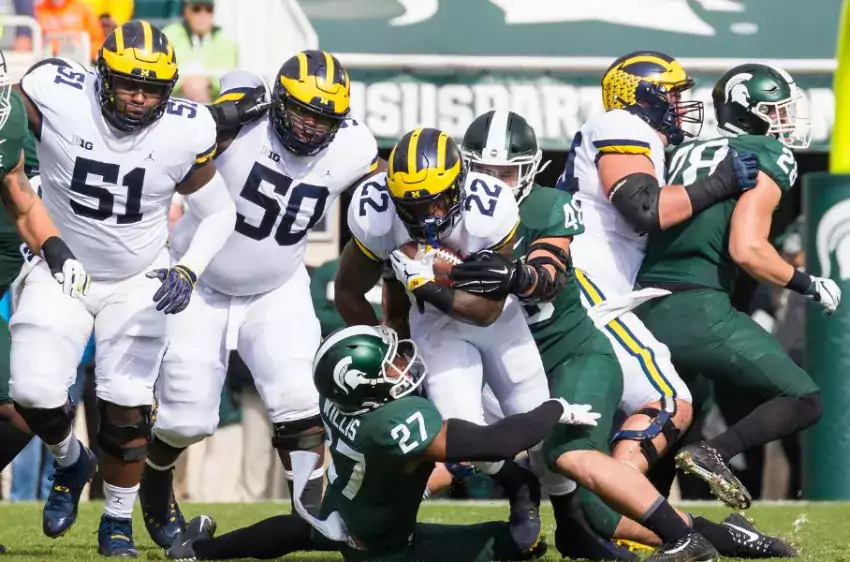
I challenge anyone to find a greater irony in football than the fact that the spread 'n shred offense was rejected at Michigan by Rich Rodriguez and restored under Jim Harbaugh. Rich Rod scrapped it in 2010 because Denard wasn't good at option reads. Hoke avoided it because he had other plans. Harbaugh is on everybody's short list of best coaches in the country for Hoke's plans.
But here we are, running not just zone reads and split zone as a check, but the checks to the checks. Last week I got into the arc keeper, a counter off split zone that can hit for big yardage. But Michigan was also making heavy use of "Belly", a Rodriguez favorite from 2008-'09 that looks like a zone read but is actually doubling the backside DT and planning for the cutback. And it did its job.
Let's break out our 10-year-old playbooks and see how it works.
The Standard Defense of Zone Read
Since this is really a counter to a base play it's best to first understand the base play: the Zone Read option. You're familiar with zone read, but probably more so with the option part. For this exercise you need to pay more attention to how it's blocked.
After the backside end is dealt with by the option, the play becomes, well, whatever off-tackle run play you want to use. You can run inside zone, outside zone, even Power-O or Down G with it. In the above example it's inside zone, and when running the zone read game out of a pistol formation this is by far the most common run play.
[After THE JUMP: gliding downhill]
Zone running rules are simple: 1) Get the linemen blocked, 2) Get your extra material to the linebackers. 3) Seal or run off the defenders to create running lanes. Let's go left to right with their thought processes versus this (base 4-3 over) front:
- Left tackle: Release to the WLB.
- Left guard: Get this NT blocked with help from my Center so we can get one of us to the LB level
- Center: Help the LG get this NT blocked so I can get to the LB level
- Right guard: Get this DT blocked with help from my RT if necessary so he can get to a linebacker
- Right tackle: Make sure my RG has this DT blocked so I can get to the LB and create a crease.
- Tight end (Y): Kick out this LB so there's a nice big lane to run out.
- Running Back: Find the gap that forms, starting with off-tackle then work back to a cutback lane.
Often in the course of running inside zone read, the quarterback has to take some time to make his read while the defense is reacting to the blocking. By the time the running back has the ball every defender is doing a fair job of closing every frontside gap and forcing a cutback towards that unblocked end:
Many a good inside zone read has died this particular death. The linebackers react too quickly for blockers to get down to them, and the linemen are intent on not letting your guys release, and your poor zone read run is now left to burrow into an unblocked LB's gap or cut back into the space between the unblocked end and the backside tackle.
But what if that was the plan all along?
Belly
Belly as we define it here* is a zone read play occasionally called "Double Dive" or "Read Dive" that attacks the cutback lane without ever having to cut back to it, giving the RB a direct shot at the backside while it's still pried open by the DE being optioned, and prying it open further by blowing the backside DT down. On a handoff all the back has to do is shoot straight ahead into the gap between the option and the ass-kicking.
For the first second after the snap, Belly moves like an inside zone read: The quarterback and running back get a mesh on, the tight end is kicking, the RT is threatening the next level, the RG is trying to get around the frontside DT, and the backside guard and tackle appear to be combo'ing the backside DT.
Except they're not getting off that NT. In fact they're moving him quite a bit. In fact there's starting to be a lot of space on that backside there. In fact: oh crap!
By the time that tackle realizes this double isn't some temporary nuisance en route to the second level but a planned thing to move him off the line of scrimmage, it's too late to do much about it. That's the whole point of a designed cutback: You want the defense to react to the direction inside zone attacks, so when the play cuts back they're caught on the wrong side of it.
* [As with many football terms this one gets used to mean different things. We got it from Rich Rod's WVU playbook, and that probably misappropriated a Wing-T play that's similar to Down-G.]
Belly in Action
Here's an pair of examples from the Wisconsin game. In fact they're the two plays directly after the 81-yard run I drew up last week. That too had a little belly action, i.e. they were doubling the backside DT.
The way I draw my play graphics makes it hard to tell how far the whole mass of bodies shifts. Note while you watch that the running back is going straight down the hashmark. It's not a cut; this play goes straight through the liver.
Play 1:
One thing to note from the above is the Pistol formation. If you have a super electric running back and run a lot of outside zone with your zone read (like Rich Rod) you can get away with a pure shotgun formation, but time is of the essence and the RB's downhill action from a pistol set can make all the difference when trying to run by the optioned guy.
Another thing is Wisconsin's in an odd (3-4 or 4-3 under) front, but the same rules apply: Wisconsin's "weakside end" is a defensive tackle in all but name. By adding a tight end to the backside the offense can still get that free release on the linebacker behind the guy they're doubling. Some teams also do it with a lead blocker.
Play 2:
An obvious question with any zone run is what do you do about a slant. If they slant away from the playside the last blocker has block the last unoptioned guy since you can't take his buddies off the double on the DT. This should bring a linebacker (or in this case a safety) around to be optioned.
This one caught a slant but the blockers are all on their toes and pick it up, even Gentry, who had the hardest job. It's hard to represent on the drawing but Wisconsin's line slanted so far that Higdon wound up barreling straight down the hash mark they started at and Bushell-Beatty planted the "SE" two yards inside of it.
The "ZONE" of the zone read also comes into play. According to Rodriguez this wasn't referring to the blocking but the area the QB reads for a defender to option. The difference between reading a player and whoever's in that zone becomes apparent when the defensive line slants. The SAM (#17 Van Ginkel) was the end man on the line of scrimmage when they lined up, but when it came time to read it was the strong safety holding the edge. That safety made the read hard, and Patterson countered by riding the mesh point almost all the way to a shared TD. By the time Higdon has the ball to himself the safety has shuffled down to meet him but there's no way a safety is stopping a Higdon.
I know we all bemoaned the lack of Bench Mason when Michigan got down to the 4 and 2 yard lines, but this play really gets the job done. The extra defender who has to commit to Patterson's legs can't be shooting in without a blocker, and the dive-ness of the backside handoff hits downhill and quickly like a good short gainer should.
The Harbaughification of Belly
I mentioned earlier you don't have to run this with a simple spread zone read look. In fact against Michigan State, the Wolverine offense added all sorts of blockers to the concept.
Here's a critical 4th and 2 early in the 4th quarter. It's a mark of how much Michigan trusts their belly game that this is their go-to short yardage play in such a situation.
Mason is indeed out there as the tailback (though back when the Flexbone was all the rage that guy was called the fullback). But this ain't no "We're diving the fullback—try to stop it" play. Okay, it is, but there's also a zone read, and now you really get to see what we mean when we say this spread 'n shred concept makes the defense play 11-on-11.
The play is blocked like it's meant to be a split zone duo. Duo is an inside zone play with extended doubles on both DTs. Split zone is that zone read counter where the guy who thinks he's being optioned suddenly discovers he's getting kicked with a fullback/TE/H-back coming opposite the flow of the play and the RB, who was always getting the ball, scoots through the resulting gap.
If it was Split Zone Duo, Michigan State has this solved:
The cornerback and strong safety on that side have to deal with Martin and Gentry in coverage so they're out. Michigan's doubling the DT (yellow), letting the DE (green) upfield to be kicked by McKeon, and bringing Mason on a dive. Sparty's plan is to hammer down the MLB (Joe Bachie) so Onwenu has to come off the double on the DT (Raequan Williams) who should be able to handle a single-block without giving up room. To cover the edge they will gap exchange: the DE (Willekes) is going to crash inside, thus putting his confrontation with McKeon right in the way of a dive. Willekes is replaced by the "Star" linebacker (Andrew Dowell).
I just named all four guys I starred on the MSU FFFF diagram. They're all selling out against a split zone, the exchange giving MSU equal numbers against a handoff while saving a safety. The result is a mass of bodies at the point of attack and a dead play because—if we're looking at split zone—the quarterback is just a guy delivering the ball then watching the play. Except he isn't. He's….
Ahem…
YO, CAMERAMAN! Pan down, man!
Hahahahahahahahahahahaahahah!
Lessons:
1. See the four star players of Michigan State's defense?
Point at them.
HAhahahahahahahahahhahahahahahahahahahahahaahaha!
2. Michigan State should have defended this better
Very true, and the guy to blame is Andrew Dowell, the optioned guy, who sold out 100% on the FB dive, leaving Patterson an easy read and a wide open edge. It's possible he thought Willekes, being outside of that crack block and all, should have been set up to contain and force a handoff. But no: when you crack/replace the guy who cracked is the guy inside and the replacement has the outside. Willekes shouldn't be expected to reverse his momentum into a guy, turn around and chase a quarterback with good legs who started facing the opposite direction. If Dowell set up outside and forced the give the blitzing linebackers created enough of a jam to have a shot at stopping even Ben Mason, and certainly not giving up more than two.
That's relevant to us because opponents are still playing the early season tendency—which in fairness to them resurfaced on that unbalanced arc zone read that Patterson wishes he had back. They also might believe pushing all their chips in against a full Ben Mason is the only way to win this play. Having an offense that forces the opponent to do unsound things that make them risk looking stupid is part of having a good offense.
3. This is a good play
Compared to other short yardage options, this one might be a little more susceptible to getting entirely blown up, but it's also likelier to have a high success rate because the quarterback cancels out a front seven defender. Even with the LB blitz, if Dowell plays this right it's Ben Mason going down hill behind Juwann Bushell-Beatty, who did in fact win his battle with Williams.
While any play can break big, operating so closely to an unblocked guy and leaving linebackers unaccounted for tends to lead to modest gains. Michigan isn't marching down the field with Belly. They can use it as a tough to stop 3rd/4th & 2 option, and bust it out some more when they're running their regular zone read option game to keep the defense from overplaying the frontside or overcommitting to defending split zone and arc zone.
4. It's zone—you can change gaps still
Often—especially when the defense shifts to an odd front—when running Belly the original running lane gets jammed up. Like Duo, while the play design calls for extended doubles, it can easily become an inside zone if the defense plays it irresponsibly. Cutback gaps can and do form.
5. Belly may be Rodriguezian but it's also very Harbaugh
Doubling a DT with Juwann Bushell-Beatty and Michael Onwenu. Straight downhill runs. Opportunities for all sorts of crazy blocking angles. I'm sure Bo would approve.

10/13/2018 – Michigan 38, Wisconsin 13 – 6-1, 4-0 Big Ten
Like anyone still standing after a 2-15 run against Ohio State, I have withered into a cynical-ass bastard more tree than man. We are the Michigan ents. The Ments. But even though this heart was long ago replaced by lignin, by God I felt it beat when Roy Roundtree and Denard Robinson popped up on the video board before the game. They talked about night games at Michigan Stadium in general. They also talked about one very specific game. I had feelings.
I did not know I had just been handed the most critical bit of the gameplan. Wisconsin did not, either. Wisconsin apparently did not know quarterbacks were, like, allowed to keep the ball. I feel like they should have known this. Even if they were completely unaware of the last 20 years of college football, surely their review of Michigan's game tape would tip them of that yes, occasionally the quarterback guy runs with the ball, and faster than you'd think.
Nope.
Patterson pulled twice more, once for a redzone touchdown and once for another chunk run. The last saw Wisconsin actually respect the idea of a pull, somewhat, but Patterson was able to outpace a wrong-footed Badger defensive end anyway.
Then the backups came in and things went from intriguing to bizarre and hilarious. Dylan McCaffrey is slashing inside a block and outrunning an All-American linebacker to the endzone! Okay!
TJ Edwards is sad in the background [Eric Upchurch]
Joe Milton, who had approximately zero rushing yards in high school, is switching fields and outrunning the whole Badger defense to the other sideline! I thought this was Diet Coke, not Meth Coke! Who put meth in my Coke? Did you also give some to Paul Chryst? Ah that's fine then, good move.
-------------------------------------
Michigan's season-long con took in both the Badgers and your author; now revealed, it resets season expectations. Harbaugh noted the impact it had on Wisconsin's run defense when they suddenly had to play 11 v 11:
Coach, you had two quarterbacks that were a big part of things as far as running the ball. Was that element added to this game?
“Yeah, it was big. Shea (Patterson) really got things going in the first quarter with the long run. And the touchdown run he had, he was — allowed us to stretch their defense, get all their gaps, make them cover — make them account for as many gaps as we could. So that was a gameplan well-executed.”
Michigan spent most of their short yardage snaps in this game in a two-tight-end shotgun look that had everyone in Michigan Stadium agonizing about the absence of Ben Mason, but aside from one bad decision from Higdon to press outside Michigan converted every time. Frequently this was accomplished by a running back cutting back behind Juwann Bushell-Beatty, who was paving his man, as a Wisconsin defender gave Patterson his newfound due.
Maybe I'd been primed by the pregame video, but I thought about Michigan's approach in Denard's other Notre Dame masterpiece, the one on the road: after a slant to Roundtree set Michigan up at the two on Michigan's winning drive, shotgun, QB zone stretch, easy cutback, TD.
Patterson's not Denard Robinson but he's certainly fast enough to demand someone account for him. When that gets combined with a mauling right side of the line and a rapidly developing whole, you get something. You get 320 rushing yards. You get nearly 240 of those in the second half. You get fourth quarter drives on which Wisconsin knows you're going to kill the clock and can't stop you on six straight runs; the clock only stops getting stabbed to death 40 seconds at a time because you accidentally score a touchdown.
With the mesh point suddenly a real thing, possibilities open up. Ends can't charge willy-nilly at the quarterback. You can make those token play actions into defense-crippling ones with the extra time that buys you—something that Ohio State just struggled to defend this weekend. The corner that Michigan could turn to become a juggernaut offense is there, shockingly in sight.
HIGHLIGHTS
AWARDS
Known Friends and Trusted Agents Of The Week
JBB is almost out of this shot, which is good [Fuller]
![-2535ac8789d1b499[1]](https://mgoblog.com/sites/mgoblog.com/files/images/537fc4d56c20_9177/-2535ac8789d1b4991f1c37dee-a502-44d9-94ed-bee425f87474.jpg) you're the man now, dog
you're the man now, dog
#1(t) Juwann Bushell-Beatty and Jon Runyan Jr. Seriously. Not ironically. Not even in a throw-these-guys-a-bone sense. Patterson was iffy, Higdon fumbled, the defense didn't have a guy contributing except in scattered bursts: JBB and Runyan were the Michigan players most consistently helping Michigan down-to-down.
I don't think either gave up a pressure. JBB paved guys on a series of plays that cut to his side of the line; he was also the source of some of those zone stretch cutback runs. Meanwhile Michigan was usually running to Runyan's side of the line.
DOD was low with Wisconsin in desperation mode at DE, but I be like dang all the same. Both guys get three points because they're made up and don't matter and also this portion of the writeup is indeed me throwing them a bone.
#2 David Long. Both Long and Hill were avoided all night until the late Wisconsin TD drive when Hornibrook went after Hill's excellent coverage. Long didn't suffer those Mr. Tight Windows slings and arrows and was able to sell him twice on man coverage that turned out to be a trap—more below—that turned into a PBU and an interception.
#3 Karan Higdon. Did fumble. Did miss a hole or two. Also went over 100 yards and made some nice zone cuts; his ability was a major reason Michigan won a game in which they had four second half passing yards.
Honorable mention: The Spirit of Denard. Paul Chryst.
KFaTAotW Standings.
7: Chase Winovich (#1 ND, #3 SMU, #1 NW)
5: Karan Higdon (#1 WMU, #3 Nebraska, #3 Wisconsin).
4: Devin Bush(#3 ND, #1 Nebraska), Rashan Gary(#2 WMU, #2 Nebraska), Shea Patterson (#3 WMU, #1 Maryland).
3: Zach Gentry(T1 SMU, #2 Maryland), Juwann Bushell-Beatty(T1 Wisconsin), Jon Runyan Jr(T1 Wisconsin).
2: Ambry Thomas (#2 ND), Donovan Peoples-Jones(T1 SMU), Josh Metellus(#2 SMU), David Long(#2 Wisconsin).
1: Will Hart (#3 NW), Mike Dwumfour (T2 NW), Kwity Paye (T2 NW), Josh Uche (T2 NW), Khaleke Hudson(#3 Maryland).
Who's Got It Better Than Us(?) Of The Week
That would be a game-sealing pick six. Alex Hornibrook has to be sick of watching Michigan defenders spear his passes with one hand.
Honorable mention: 81 yard Patterson run; McCaffrey touchdown; Interception #1; DPJ almost breaks another punt; Wisconsin roughs the snapper; various Paul Chryst punt decisions.
 MARCUS HALL EPIC DOUBLE BIRD OF THE WEEK.
MARCUS HALL EPIC DOUBLE BIRD OF THE WEEK.
Wisconsin busts a jet sweep to tie the game and momentarily give people the willies about whether Michigan can stop this run game at all.
Honorable mention: The two stunning Winovich holding calls that didn't get made; Michigan's inability to capitalize on the first INT; ESPN having the Chainsmokers on to pick games instead of Denard.
[After THE JUMP: What are you doing, Turtle?!]
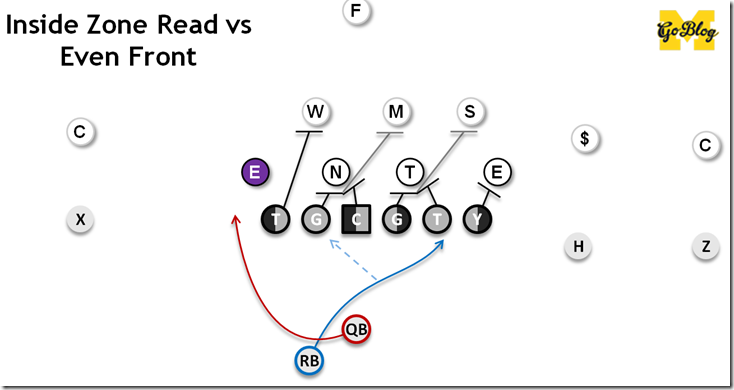
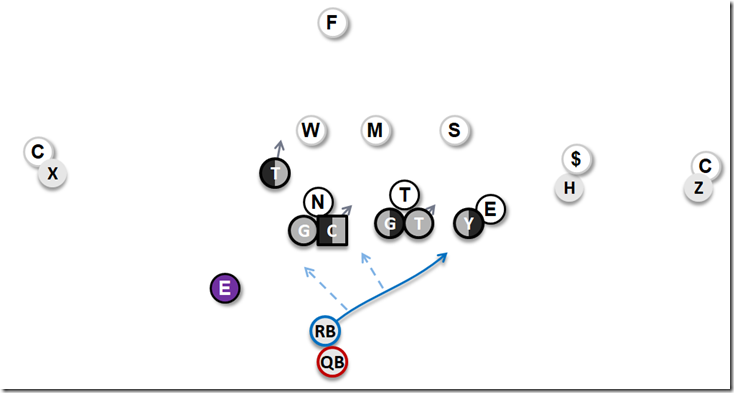
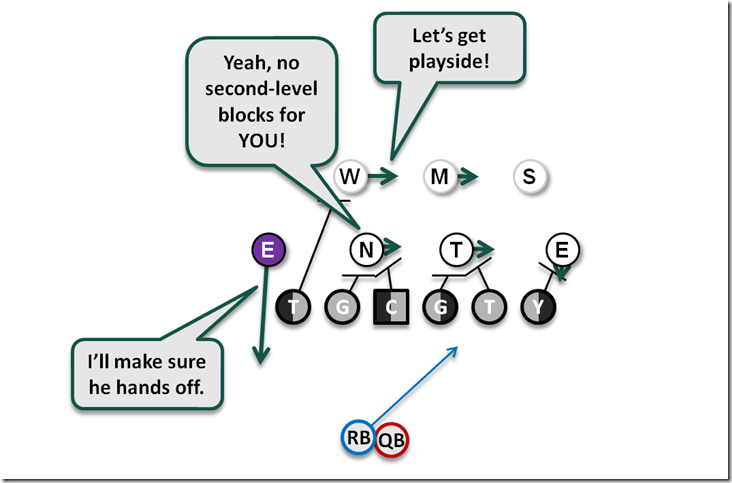

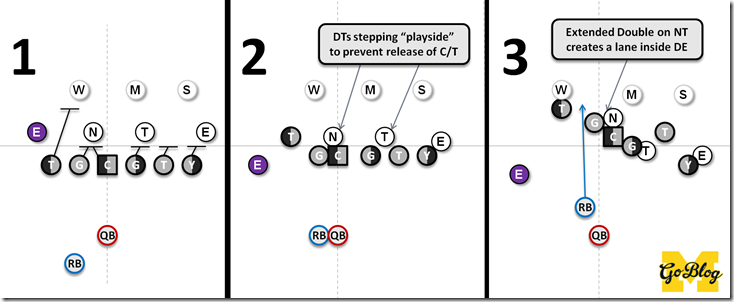
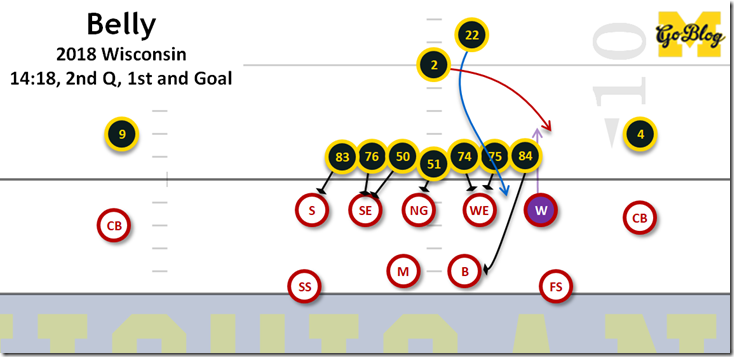
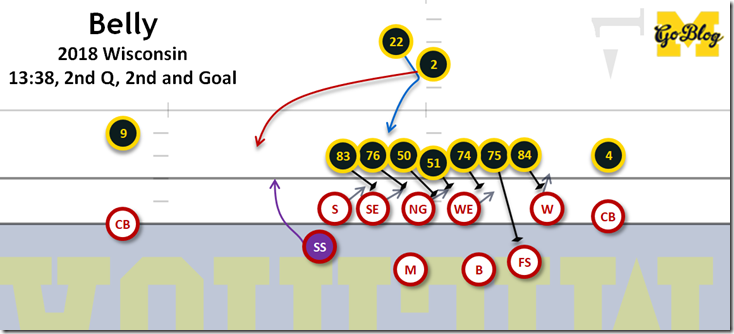
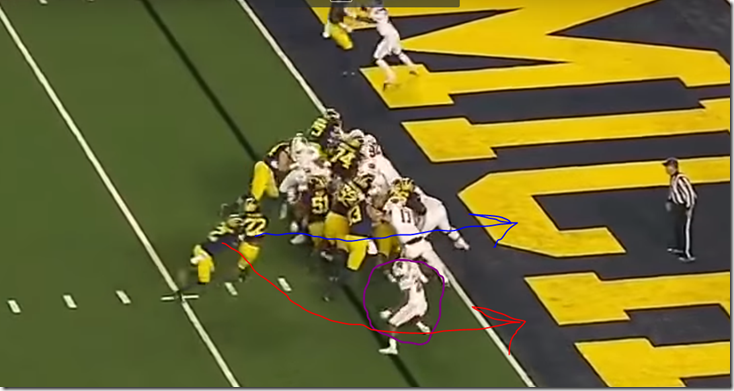

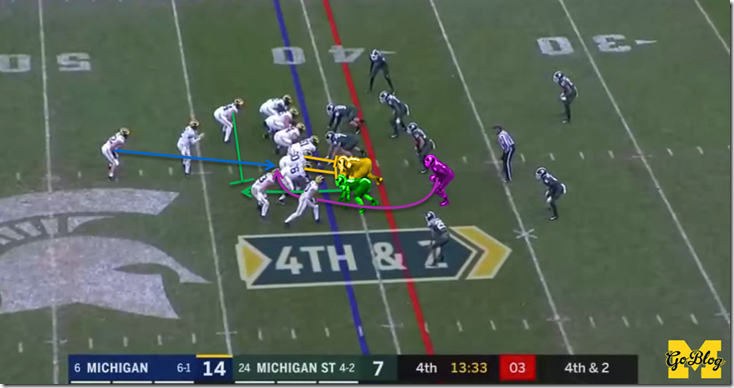

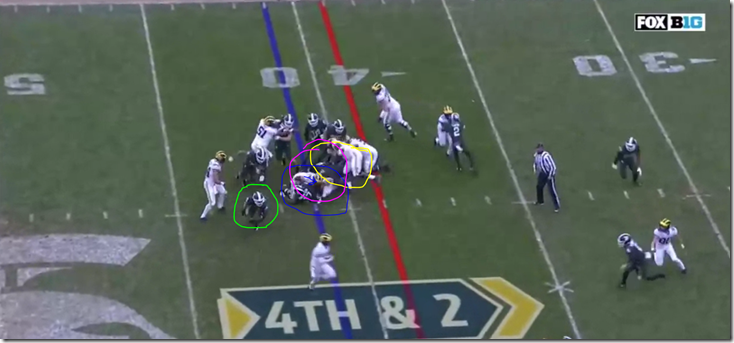
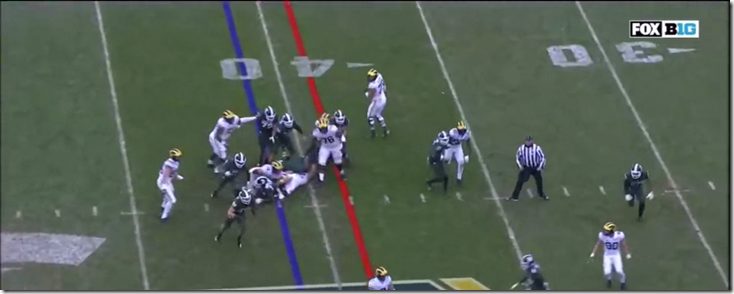
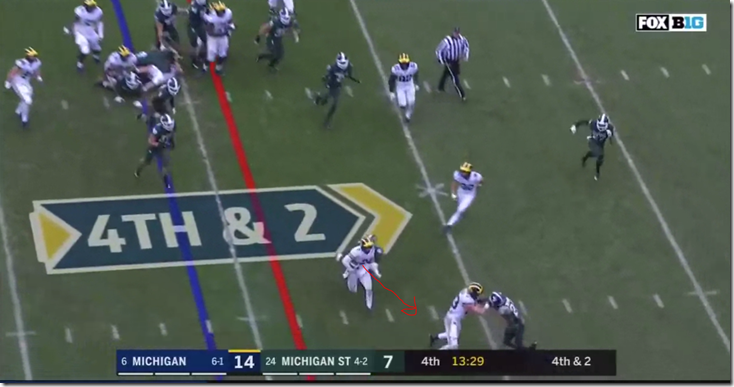

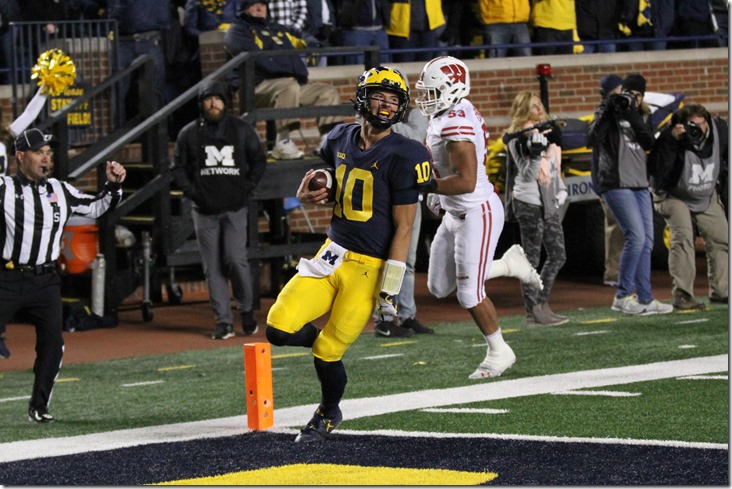
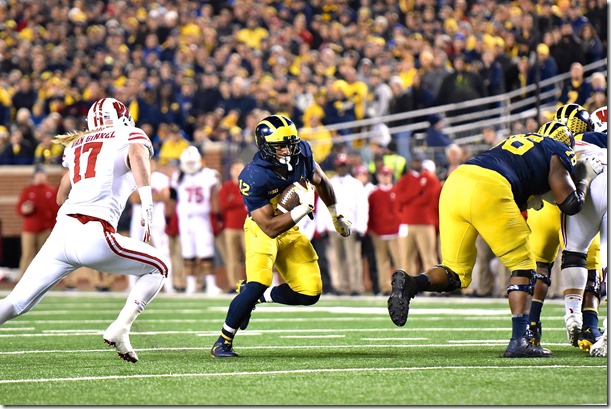
63